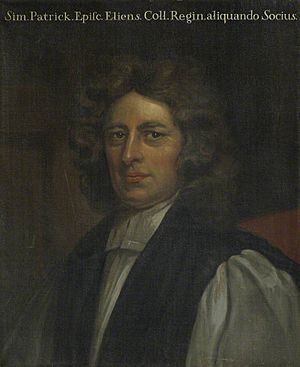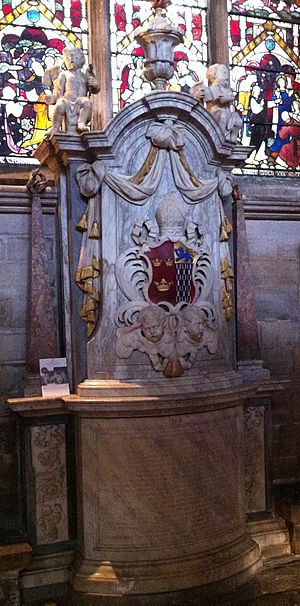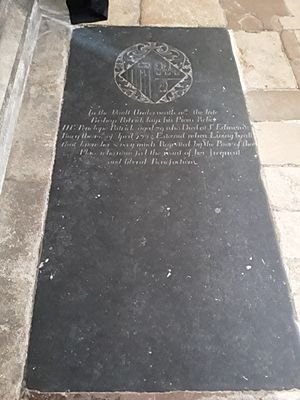Simon Patrick facts for kids
Quick facts for kids The Right Reverend Simon Patrick |
|
|---|---|
| Bishop of Ely | |
 |
|
| Church | Church of England |
| Diocese | Diocese of Ely |
| In Office | 1691–1707 |
| Predecessor | Francis Turner |
| Successor | John Moore |
| Other posts | Dean of Peterborough (1679–1689) Bishop of Chichester (1689–1691) |
| Personal details | |
| Born | 8 September 1626 |
| Died | 31 May 1707 (aged 80) |
| Buried | Ely Cathedral |
| Nationality | British |
| Denomination | Anglican |
| Parents | Henry Patrick (father) |
| Spouse | Penelope Jephson |
| Children | Simon |
| Education | Boston Grammar School |
| Alma mater | Queens' College, Cambridge |

Simon Patrick (born September 8, 1626 – died May 31, 1707) was an important English religious leader and writer. He served as a bishop in the Church of England.
Contents
Simon Patrick's Life Story
Early Years and Education
Simon Patrick was born in Gainsborough, Lincolnshire, England, on September 8, 1626. His father, Henry Patrick, was a wealthy merchant. Simon went to Boston Grammar School and later studied at Queens' College, Cambridge, starting in 1644.
Becoming a Church Leader
After becoming a priest in 1651, Simon Patrick took on several important roles in the church. He worked as a chaplain for Sir Walter St. John. He then became the vicar of Battersea in Surrey. In 1662, he became the rector of St. Paul's church in Covent Garden, London. He continued his work there even during the time of the Great Plague.
Important Roles and Later Life
Simon Patrick was appointed Dean of Peterborough in 1679. This was a high position within the church. In 1689, he became the Bishop of Chichester. During this time, he helped organize church matters in Ireland. In 1691, he moved to become the Bishop of Ely, a role he held until he passed away on May 31, 1707. He was buried in Ely Cathedral. He also had a building called Dalham Hall constructed.
What Simon Patrick Wrote
Books and Commentaries
Simon Patrick wrote many sermons and religious books. One of his most famous works is his Commentary on the Historical and Poetical Books of the Old Testament. This large work, in 10 volumes, explained parts of the Old Testament of the Bible. It was later included in a bigger collection of religious writings in 1810.
Debates and Other Writings
He also wrote a book called Friendly Debate between a Conformist and a Nonconformist in 1668. This book was part of a discussion about religious rules at the time. He also contributed to a collection of Poems upon Divine and Moral Subjects published in 1719. Later, his complete works were put together in a collection in 1858. A small book about his own life, called Autobiography, was published in 1839.
His Beliefs and Family
His Religious Ideas
Simon Patrick was influenced by other important religious thinkers like Henry Hammond and the Cambridge Platonists. He was known for his Arminian beliefs, which are a set of ideas within Anglican Christianity. Historians describe him as an influential Arminian Anglican.
His Family Life
In 1675, Simon Patrick married Penelope Jephson, who passed away in 1725. Penelope was the daughter of Maj. Gen. William Jephson, a powerful member of Parliament. Simon and Penelope had three children together, but two of them died when they were young.


